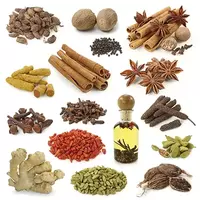Spices and seasonings

Even in the Middle Ages, spices and seasonings, as well as spices, were considered a sign of noble origin, wealth and high position in society. Commoners and even well-off traders couldn't afford to pay for exotic spices and seasonings in pure gold. Nowadays, you won't surprise anyone with spices and seasonings. Indeed, in the kitchen of any modern hostess, you will find the minimum set of classic spices, seasonings and spices necessary for cooking.
In accordance with the terminology adopted in the food industry, seasonings, spices and spices are nothing more than flavors that can be of both plant, i. e. natural, and synthetic origin. However, the main feature. spices are considered to be of exclusively natural origin. The thing is that various components of plants, herbs and vegetables are used for the production of spices. A fairly extensive group of products belongs to the category of spices and seasonings.
Among the most basic types of spices and seasonings can be distinguished such classic ingredients of most culinary products as salt, as well as sugar, vegetable oils, sauces (ketchup, mustard), and in addition acetic essence, sodium glutamate or the "fifth taste of umami. " Spices are called starch or vinegar, as well as other substances that are used in cooking to give the finished dishes a brighter and richer aroma, as well as taste. All types of spices and seasonings are divided into several main categories:
mineral spices and seasonings such as salt;
vegetable spices and seasonings, i. e. spices;
synthetic spices and seasonings such as sugar, vinegar, and citric acid;
mixtures of spices and seasonings, among the most common and widely known can be distinguished ajika, Indian curry or masala, as well as hop-suneli.
The calorie level of spices and seasonings will depend on one determining factor - a type of taste additive. The calorie content of spices and seasonings of various types can differ significantly from each other, this is explained by the chemical composition, as well as the method of production of a particular product. For example, food salt is characterized by a zero calorie level, and indicators of licorice root or liquorice are 375 kcal per 100 grams of product.
Composition of spices and seasonings
The chemical composition of spices and seasonings also depends primarily on the variety of product. for example, the composition of spices and seasonings of natural origin contains a large amount of useful vitamins, as well as other natural compounds that have a positive effect on human health. It is worth noting that both the harm and benefits of spices and seasonings lie primarily in the composition of flavors.
The benefits of spices and seasonings
Currently, some nutritionists and even doctors have seriously started talking about the dangers of spices and seasonings. as the scientific world has ever crashed into two opposing camps. Proponents of the use of spices and seasonings for culinary purposes argue that the vast majority of flavors are not just safe, but even good for humans. The benefits of spices and seasonings are that flavors saturate culinary products with additional useful compounds of natural origin. In addition, some types of spices and seasonings have healing abilities.
For example, red or hot hot peppers have long been used in Asian countries as a natural natural antiseptic. The benefits of spices and seasonings can be expressed in the ability to have a beneficial effect on the entire human body as a whole. In addition, spices and seasonings increase immunity, normalize digestive and metabolic processes, and also positively affect the health of skin and hair. However, in addition to the obvious benefits, some types of spices and seasonings can be harmful.
Harm of spices and seasonings
It is worth noting that spice and seasoning can be harmed in the event of uncontrolled consumption of large quantities of the product. In addition, spices and seasonings can cause allergic reactions in people suffering from individual intolerance to the product. Nutritionists and doctors advise to avoid frequent consumption of food products, for the manufacture of which synthetic flavors were used. The spices and seasonings obtained in the laboratory as a result of the chemical reaction can cause serious damage to human health.
spices and seasonings 255 kCal
Energy value of spices and seasonings (Ratio of proteins, fats, carbohydrates - ju):
Proteins: 10.95 g (~ 44 kCal)
Fats: 3.26 g (~ 29 kCal)
Carbohydrates: 38.31 g (~ 153 kCal)
Energy ratio (b | y): 17% | 12% | 60%
 Español
Español Français
Français Português
Português Русский
Русский 简体中文
简体中文 繁體中文
繁體中文 日本語
日本語 한국어
한국어 العربية
العربية Türkçe
Türkçe Қазақ
Қазақ Deutsch
Deutsch Italiano
Italiano Українська
Українська
